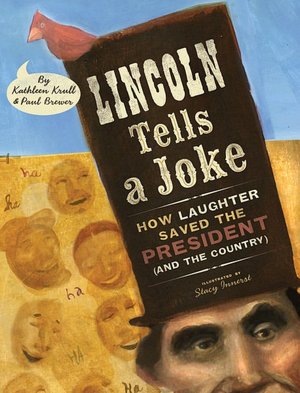BIBLIOGRAPHY
Krull, K., Brewer, P. (2010). LINCOLN TELLS A JOKE: HOW LAUGHTER SAVED THE PRESIDENT (AND THE COUNTRY). Ill. by Stacey Innerst. Boston, Mass.: Harcourt Children's Books/Houghton Mifflin Harcourt. ISBN: 015206639X
PLOT SUMMARY
CRITICAL ANALYSIS
LINCOLN TELLS A JOKE is written chronologically, including all of the major events of Lincoln’s life: birth, military, marriage to Mary Todd, elected to the Illinois House of Representatives, elected president, and death. With each turn of the page, there is something new to be learned about Lincoln's life. Because of the fast pace of the book and Lincoln's jokes sprinkled throughout, students will enjoy learning about his interesting life.
This story doesn't tell every detail of Abraham Lincoln's life, it instead focuses on his personality making it different from other biographies that students have probably read. Each quote is written in bigger, script style font making Lincoln's words stand out from the other text. Lincoln's love of spoken and written words is also emphasized. It was this love of learning along with his ambitious, yet lighthearted personality that helped him become so successful.
Krull uses language that is appropriate for the age group that the book is written. For example, "Lincoln was born in a log cabin in 1809, which might sound cool, but it was actually quite bleak." Students might not use the word bleak, but they would be able to figure out the meaning by the antonym included, "cool."
According to the back of the book, Stacy Innerst uses acrylic on illustration board for the beautiful illustrations. Each one directly relates to the text on the corresponding page, complementing the text nicely. The illustrations also add to the humor in the book. On the page that says, "When no ladies were around, he might joke about farts or outhouses." there is a picture of an outhouse with a puff of air coming out of it. When Lincoln is elected president, the picture shows the outside of The White House and, on the corresponding page, a small picture of Lincoln sitting in a chair inside The White House leaning back and obviously laughing. In the background of both of these pictures is the word "ha" written several times to reinforce the theme of Lincoln's sense of humor.
There is a note included at the back from the authors that states that some of the jokes in the story "were passed on by eyewitnesses; some are second-hand, third-hand, or further removed." Although the facts listed in the story are historically accurate, this statement makes the reader question whether the quotes are. Regardless, it doesn't take away the fact that Lincoln had a sense of humor that most likely is unknown to children. A list of sources used to write the book is also included at the back of the book, reinforcing the fact that it is a true biography.
AWARDS & REVIEW EXCERPTS
Awards:
Smithsonian’s 2010 Notable Books for Children
Review Excerpts:
"The legends that endure about Lincoln are many: his log-cabin childhood, his honesty, his eloquence. What is less-often discussed is how he used humor to diffuse tense political situations, disarm critics, and undo the stresses of running the country. His love of words in general, and jokes and humor more specifically, helped him throughout his life when things were difficult, uncomfortable, and downright dire, as they often were during the Civil War." School Library Journal (March 1, 2010)
CONNECTIONS
Use LINCOLN TELLS A JOKE to teach about persuasive writing - http://teachwithpicturebooks.blogspot.com/2010/04/so-whats-your-point-persuasive-writing.html
Watch an interview with Kathleen Krull - http://www.readingrockets.org/books/interviews/krull/
Read this book out loud to students around President's Day
Have students illustrate a timeline of events in Abe Lincoln's life
Read aloud to students when learning about the Civil War
Readers Theaters on Abraham Lincoln - http://printables.scholastic.com/printables/detail/?id=38940 , http://printables.scholastic.com/printables/detail/?id=38938 , http://printables.scholastic.com/printables/detail/?id=38941
Short 3 minute video on Abraham Lincoln - http://video.nationalgeographic.com/video/places/culture-places/historical/abraham_lincoln/


No comments:
Post a Comment